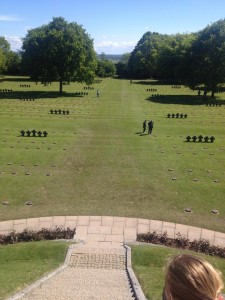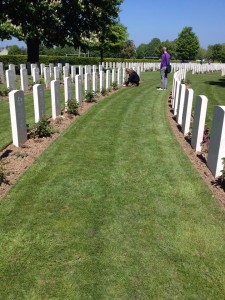Honoring the fallen and memorializing events is a crucial way to educate people about the past, remember what has happened, and provide closure to those in need. When I walked through the arch that led to the German cemetery, La Cambe, I was overwhelmed by the flatness, uniformity and lack of love in this place. I don’t know what I expected, but this plot of land did not live up to my expectations in the slightest. The land was covered in small headstones laid flat on the ground, scattered with groupings of five, rough stone crosses and had a large hill with three of the same stone crosses at the top. The cemetery is where those who fought for their country lay to rest, yet there were no signs of gratitude, appreciation or honor for these soldiers. The Germans were the enemy at Normandy, and it is clear that they were buried as such. I understand and am acknowledging that the German troops as a whole were responsible for the loss of so many Allied lives, yet these soldiers were people, too. I had a hard time walking around that cemetery; the whole time I was in distress. While WWII was a battle between the Allies and the Axis powers, it is unfair to say that every German soldier was evil and driven by a Nazi ideology that does not deserve a memorial.
The American cemetery at Coleville sur Mer, on the other hand, is grandiose and showy. There is a museum to explore prior to entry that outlined the events leading up to and during D-Day. As I walked into the cemetery, with the Star Spangled Banner playing from speakers planted in the beautiful flower beds around me, I saw a beautiful memorial to the soldiers. There was a stunning display of names of Americans who lost their lives on D-Day on a wall that framed a showy statue. On either side, there were large maps on marble detailing the events of the day and of the invasion. Finally, well-groomed trees framed a large reflecting pool leading guests to the burial grounds. There were six plots of land with rows of headstones arranged neatly; everything was well-labeled and the place was easy to navigate. We arrived at the cemetery with a bouquet of thirteen roses, the number of Buckeyes who gave their life during WWII and were buried at the American cemetery. Each student was given information about one of the Buckeye 13 that we then individually shared with the group as we laid our rose at the soldier’s grave, commemorating their service. Their tombstones displayed their name, rank, involvement in the military and dates of life and death. Uniformity is a theme throughout the American cemetery, from the perfectly straight rows to the similar headstones, it is clear that while the cemetery pays homage to the fallen, equal respect is given to all. And yet, this place felt impersonal, stark and cold, as if the American military was a machine of some sort.

The British Cemetery was absolutely touching. When I walked in, I was initially underwhelmed, seeing rows of headstones just like the previous cemeteries I had seen. It appeared to be just another burial ground, until I began wandering around. There were beautiful flower beds at the foot of each headstone and scattered around the grounds. This place was truly a memorial to those whose lives were lost during the Second World War. Within its groomed-hedge walls, there were people from all over the world buried there. This ground was a memorial to British, American, Canadian, German, Italian, Czech, Soviet, Australian and Polish people. The cemetery was the most beautiful place I’ve visited on the trip so far. Far more moving than the beaches of Normandy, it was so clearly filled with love, appreciation, sorrow, mourning, and gratitude. Many of the tombstones carried personal messages from family and loved ones to their lost soldiers; one read “will some kindly hand in that far land place a flower of love for me – Connie.” Many were signed “Mam and Pap” and included phrases about how they were appreciative and regret not being there to say goodbye to their brave child. Hearing statistics in class about death rates during the war meant nothing to me, I could not grasp how much devastation came as a result of total war. Walking around the British cemetery, I was reminded that the fallen were not only soldiers but neighbors, friends, children.

